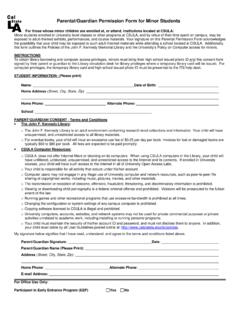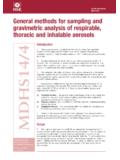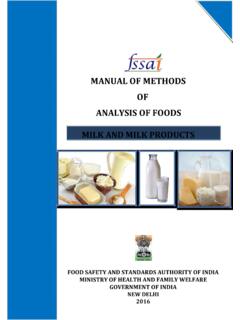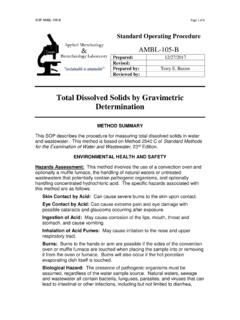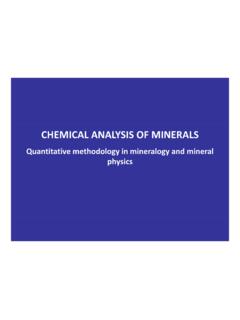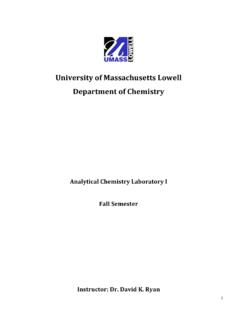Transcription of Experiment: Gravimetric Determination of Nickel
1 Chemistry 201 laboratory Page 1 of 1 1 experiment : Gravimetric Determination of Nickel The purpose of this experiment is to determine the % Nickel (by weight) in an unknown Nickel -containing ore by means of Gravimetric methods. INTRODUCTION The separation of Nickel from other ions in a sample is a good example of specificity in quantitative analysis . The amount of Nickel can be determined by precipitation with dimethylglyoxime from a slightly ammoniacal solution, filtering and weighing the dried precipitate. Note: Successful completion of this experiment within the time allowed requires that students plan their work carefully in advance (use of flow chart).
2 Also note the time required for each step: A. Sample preparation and precipitation (6 hrs) B. Cleaning, drying and weighing of glass crucibles (6 hrs) C. Filtering, drying and weighing the Ni(DMG)2 precipitate (2 hrs) Parts A and B can be done in parallel and is suggested to save time. EXPERIMENTAL PROCEDURE NOTE: Do the drying of ore the lab session before you are scheduled to do the experiment . A. Transfer the unknown Nickel ore sample into one weighing bottle and bring to constant weight by drying. After drying, weigh accurately by difference three samples (about g each), into numbered 400 ml beakers. In the fume hood, add 20 mL conc.
3 HNO3 to each sample, cover with watch glasses (use glass hooks) and warm gently on the hotplate in the hood. Reddish fumes will evolve and all of the sample should dissolve. Continue heating gently until the volume of each solution is reduced to approx. 5 mL (to ensure that all of the iron present is in the Fe (III) state and to reduce the amount of HNO3 present, and therefore the NH3 required for its neutralization). Dilute the solution to about 250 mL with deionized water. In the fume hood, add about 6 mL conc. ammonium hydroxide (NH4OH) to the solution (leave one stirring rod in each beaker until filtration is completed).
4 Add 5 g of solid tartaric acid (weighed out in advance on weighing paper) to the sample solution, stirring until dissolved. In the fume hood, add 6M ammonium hydroxide (NH4OH) until a pH of 8 to 9 has been reached (ask your GA for a hand-held pH meter). Note: If a precipitate is produced during this step, add another 1g of tartaric acid to redissolve it. Iron (III), chromium (III), aluminum (III) and bismuth (III) will precipitate as hydroxides if insufficient complexing tartaric acid has been added. Cobalt (II), manganese (II), copper (II) and zinc (II) will form soluble amine complexes in ammoniacal solution. Tungsten and silicon will remain insoluble and interfere if present.
5 Thus, insoluble residue at this point should be filtered, washed with dilute aqueous ammonia solution and the washing added to the sample solution. Chemistry 201 laboratory Page 2 of 2 2 Heat the solution until some steam comes out (Note: Don t boil the solution!) and add 20 mL of 1 % alcoholic dimethylgloxime solution dropwise with constant rapid stirring. Keep the beakers covered as much of the time as practical. A bulky red precipitate will form during this addition. Digest the solution and precipitate on the hot plate for at least one hour to produce a coarse, easily filtered precipitate. Note: Do not boil this solution as the excess dimethylgloxime will precipitate from solution, giving high results.
6 Test for complete precipitation (if the surface is clear of precipitates) by adding a drop of dimethylgloxime solution. Since dimethylgloxime is only slightly soluble in water, large excesses of the precipitant should be avoided in order to prevent precipitating the reagent itself. Cool all solutions to room temperature. B. If you haven t done this on the first day, clean the crucibles by removing any visible dirt with detergent solution, brush and rinse. Fill the filter flask with approx. 100 mL of water. Assemble the filter flask, rubber crucible holder and crucible. Connect the filter flask with a rubber suction. Using a wash bottle, test the effectiveness of seating of the crucibles in the holder.
7 Fill the crucible halfway with 1:1. HNO3 (prepare about 50 mLs for 3 crucibles), using gentle suction to draw acid slowly through the crucible. Fill halfway again and interrupt suction for a few minutes. Wash crucibles several times with distilled water. If the disc remained stained, draw 6 M NH4OH solution through the crucible after the acid has been rinsed out and the filter flask washed. Rewash several times with distilled water. Oven dry crucibles in a beaker provided with glass hooks and watch-glass for 1 hour. With crucible tongs, remove the crucibles to desiccator, cool for 20 min, and weigh accurately.
8 Dry crucibles again, cool for 20 min, and reweigh. Repeat this process until successive weights are constant to less than +/- mg. C. Fill the filter flask with approx. 100 mL of water. Assemble the filter flask, rubber crucible holder and crucible. Filter each precipitate through a sintered glass crucible (that was cleaned and dried previously). During filtration keep the top quarter inch of the crucible surface dry since the precipitate has a tendency to creep over and out. Test the cool filtrate with dimethylgloxime solution for complete precipitation. Wash the precipitate with about 5 mL of cold water three times using a wash bottle.
9 Dry the precipitates, cool in the desiccator and weigh (Note: Don t over heat the precipitates in the oven). Repeat this process until constant weight is obtained. Calculate the percent Nickel present in the ore. Notes: If transparent, colorless needle-like crystals appear in the final Nickel dimethylgloxime, or if the results of the Nickel content in the ore have a high degree of variance, use the following procedure: 1. Fill each crucible containing the Ni(DMG)2 precipitate half full with ethanol and let sit for 15 min before applying suction. 2. Apply such to remove ethanol. 3. Dry the crucible and contents, cool and reweigh.
10 If the crucible has lost weight but the results appear inconsistent, repeat the procedure. Chemistry 201 laboratory Page 3 of 3 3 Discarding of Waste: Place conc. HNO3 acids in plastic nitric acid waste container Place conc. HCl acids in plastic non-nitric acid waste container Place conc. NH3 in base waste container in base hood Excess DMG in drain with large amounts of H2O. **It is important that you follow the rules of waste disposal above. If you have any questions, please see your instructor or teaching assistant before discarding waste. Further Reading: 1. Vogel. Textbook of Quantitative Inorganic analysis , Longman, London (1961). 2. Dilts.







